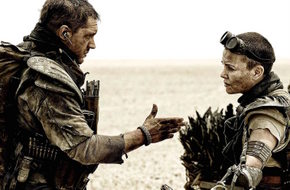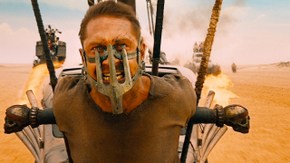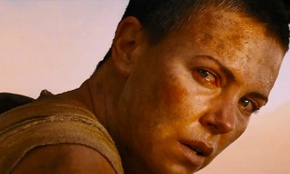 MAD MAX: FURY ROAD
MAD MAX: FURY ROAD
Tom Hardy plays the title character in Mad Max: Fury Road, director George Miller's continuation-slash-reboot of his legendary post-apocalyptic action series that began in 1979, and a movie boasting a central figure who might be the most powerful, intimidating, and deeply empathetic ass-kicker of 21st Century cinema. It's not Hardy, but he's pretty great, too.
The ass-kicker I'm actually referring to is the female warrior Imperator Furiosa, whom Charlize Theron plays with such intelligence and fearsome physicality that she threatens to make Mad Max himself borderline irrelevant. This news has certainly not gone unnoticed, or unaddressed, among "men's rights" activists; last week, without having even seen it, blogger Aaron Clarey called for a worldwide boycott of Miller's film for its blatant "feminist propaganda." (Ah, those feminists. Always pushing their agenda with big-budget action spectacle and ultra-violent chase scenes and a thunderous rock soundtrack ... just like in Fried Green Tomatoes!) And let's be clear: Fury Road is unapologetically egalitarian, and Theron's Furiosa is the movie's chief conscience and driving force. It's hardly unintentional, after all, when a climactic gunfight here rests on an ability to score a direct hit from hundreds of yards away, and Furiosa makes a successful kill shot while balancing her rifle on Max's shoulder.
Yet aside from viewers who instinctively hate action or fundamentally hate women, it's hard to imagine who wouldn't have a good time at Miller's feverishly imaginative, brilliantly choreographed opus - a work so breathlessly exciting that its also being funny and moving feels like an embarrassment of riches. During its first 10 minutes or so, I was nearly slack-jawed at the astonishing scope of this thing. During its next 105, I was still slack-jawed, but with the corners of my mouth curled into a grin, flabbergasted that something this grim could also be this gloriously entertaining. Mad Max: Fury Road isn't merely, at present, the movie of the year. It's the movie that movies desperately need right now - a wildly enjoyable reminder that Hollywood tentpoles can still amaze, that silence is frequently preferable to banter, and that blockbuster-minded set pieces needn't be their films' most tedious scenes.
 Taking over the role played, iconically, by Mel Gibson in Max Max, 1981's The Road Warrior, and 1985's Mad Max Beyond Thunderdome (the one in which Tina Turner didn't need another hero), Hardy's Max Rockatansky is a loner in a post-nuclear Australian outback, tortured by the recent deaths of his wife and daughter. Within the movie's first minutes, he's chased and captured by a group of ghostly pale "war boys" under the command of the desolate landscape's tyrannical despot Immortan Joe. (This nightmarish figure with the red-rimmed eyes and fanged death mask is portrayed by Hugh Keays-Byrne, who - fun fact! - played the Mad Max gang leader responsible for the death of Max's wife.) Yet not long after Max's detainment in Immortan Joe's slave-labor camp as a transfusion-ready "blood bag," an unexpected swarm of confusion enables his escape: The tribe warrior Furiosa, via armored truck, takes off with five of Joe's harem of "breeders" on a cross-country trek, hoping to release them to the Edenic "green place" of her birth. Max, without Furiosa's knowledge, hitches a ride. Joe, along with a battalion of war boys in tricked-out motor vehicles, follows, intent on killing Furiosa and reclaiming his brides. And therein begins the feature-length chase that composes Fury Road, which - and I mean this in the most complimentary way - is kind of like what you'd get if Sam Peckinpah re-shot the Western classic Stagecoach at double-speed with the cast of Cirque du Soleil.
Taking over the role played, iconically, by Mel Gibson in Max Max, 1981's The Road Warrior, and 1985's Mad Max Beyond Thunderdome (the one in which Tina Turner didn't need another hero), Hardy's Max Rockatansky is a loner in a post-nuclear Australian outback, tortured by the recent deaths of his wife and daughter. Within the movie's first minutes, he's chased and captured by a group of ghostly pale "war boys" under the command of the desolate landscape's tyrannical despot Immortan Joe. (This nightmarish figure with the red-rimmed eyes and fanged death mask is portrayed by Hugh Keays-Byrne, who - fun fact! - played the Mad Max gang leader responsible for the death of Max's wife.) Yet not long after Max's detainment in Immortan Joe's slave-labor camp as a transfusion-ready "blood bag," an unexpected swarm of confusion enables his escape: The tribe warrior Furiosa, via armored truck, takes off with five of Joe's harem of "breeders" on a cross-country trek, hoping to release them to the Edenic "green place" of her birth. Max, without Furiosa's knowledge, hitches a ride. Joe, along with a battalion of war boys in tricked-out motor vehicles, follows, intent on killing Furiosa and reclaiming his brides. And therein begins the feature-length chase that composes Fury Road, which - and I mean this in the most complimentary way - is kind of like what you'd get if Sam Peckinpah re-shot the Western classic Stagecoach at double-speed with the cast of Cirque du Soleil.
There's little that's more useless or boring than trying to describe the minutiae of a superlative action scene: What's the point in expending 100 words on something that takes roughly three seconds to wow the crap out of you? And that's where Fury Road poses a particular challenge to a reviewer. How do I, for example, adequately suggest the exhilaration of the sequence that finds Joe's war boys attempting to infiltrate Furiosa's truck by dangling from their speeding cars atop 30-foot pliable poles, like the samurai cascading through Crouching Tiger, Hidden Dragon's bamboo forest? Or the rolling, brutal fisticuffs in the sand between Furiosa and Max, the latter of whom happens to be handcuffed to the unconscious war boy Nux (Nicholas Hoult, finding staggering levels of sweetness in this naïve zealot)? Or, in my favorite George Miller touch, the souped-up truck accompanying Joe's army that comes complete with a half-dozen war boys pounding timpani drums and a chained-up psychopath - singer/songwriter iOTA's "The Doof Warrior" - playing electric guitar? (Apocalypse Now's Robert Duvall had Wagner's "Ride of the Valkyries"; Immortan Joe rides into battle with his own freaking punk band.)
Even to mention these narrative accoutrements is to risk making Fury Road sound unbelievably silly. But while you may laugh at these and other flourishes, you don't laugh mockingly. Everything from the timpani to the war boys' habit of spraying their teeth with silver paint in preparation for their suicidal entry into Valhalla fits in with Miller's grand vision of a post-war planet (or at least continent) gone insane; the on-screen action may appear absurd, but the logic behind Miller's detailed universe feels sound. The relentless frenzy also lends enormous emotional weight to the rare instances of respite. There's a hauntingly quiet nighttime scene, stunningly well-shot by cinematographer John Seale, in which we see Max, Furiosa, and their female charges drift through a swampland populated only by crows and random souls trudging through the morass on stilts. This sequence is already strangely touching when it ends, before you expect it to, in a fade to black. It's tremendously affecting, in retrospect, when we learn just which part of Australia our heroes were drifting through.
 A movie this technically accomplished, with production design this outstanding and stuntwork this miraculous, hardly needs the quality of performances that Theron and Hardy deliver. I'm so glad Miller never informed Theron and Hardy of that. It should be said that neither gets much help from Miller's and co-screenwriters Brendan McCarthy's and Nico Lathouris' dialogue, which, in general, is suitably curt and relentlessly on-the-nose. (Furiosa to Max, regarding Joe's harem: "They're looking for hope." "What are you looking for?" "Redemption.") But it's impossible to imagine dialogue helping matters when Fury Road's leads are so astoundingly expressive without it. Theron, her eyes framed by black soot, surveys the world around her as though she's already seen the absolute worst and expects to see more of it; while the performer is thrillingly fierce and vibrant in her action scenes, Furiosa's true reserves of power lie in the unrelenting ferocity of her stare. And while, in terms of the movie's narrative, Max could not unreasonably be called Furiosa's sidekick, Hardy exudes star charisma throughout, and probably gets more variety than any other actor could out of Max's limited supply of grunts and grumbles. (When he does speak full sentences, Hardy, as usual, doesn't make Max reminiscent of any of his previous screen characters, and blends - to my ears - a combination of Australian, British, and Midwestern dialects to sound appropriately otherworldly.)
A movie this technically accomplished, with production design this outstanding and stuntwork this miraculous, hardly needs the quality of performances that Theron and Hardy deliver. I'm so glad Miller never informed Theron and Hardy of that. It should be said that neither gets much help from Miller's and co-screenwriters Brendan McCarthy's and Nico Lathouris' dialogue, which, in general, is suitably curt and relentlessly on-the-nose. (Furiosa to Max, regarding Joe's harem: "They're looking for hope." "What are you looking for?" "Redemption.") But it's impossible to imagine dialogue helping matters when Fury Road's leads are so astoundingly expressive without it. Theron, her eyes framed by black soot, surveys the world around her as though she's already seen the absolute worst and expects to see more of it; while the performer is thrillingly fierce and vibrant in her action scenes, Furiosa's true reserves of power lie in the unrelenting ferocity of her stare. And while, in terms of the movie's narrative, Max could not unreasonably be called Furiosa's sidekick, Hardy exudes star charisma throughout, and probably gets more variety than any other actor could out of Max's limited supply of grunts and grumbles. (When he does speak full sentences, Hardy, as usual, doesn't make Max reminiscent of any of his previous screen characters, and blends - to my ears - a combination of Australian, British, and Midwestern dialects to sound appropriately otherworldly.)
Can I also take a moment to say how refreshing it is to see an effects-driven "summer" blockbuster that employs so little overt CGI? To be sure, it's gotta be there - in the grandiosity of Immortan Joe's mountainside lair and the thousands of oppressed, water-deprived citizens beneath him; in a few of the vehicles' eruptions into fireballs; in Furiosa's prosthetic left arm. (I was so intently focused on Charlize Theron's gaze that Furiosa was on-screen for maybe a half hour before I noticed that her arm below its elbow was stainless steel.) But there's a nearly tactile realness to the film's many car, truck, and bike chases that you just don't get from our currently superhero-obsessed culture, and that increases the threat and danger levels exponentially. When Iron Man and the Hulk lay waste to an entire city block, I doubt that nearly anyone in the audience is thinking about the effect of their debris-strewing punches on passers-by (or, God forbid, on whether any human beings are in all those buildings toppling as a result of their super-tiff). But whether it's our heroes or those tailing them, you feel it when Miller's characters fall under speeding cars or spears shoot into their faces; you recognize the cost of all this violence. Actions have consequences here, and they actually matter. The thrilling, unique, altogether extraordinary Mad Max: Fury Road does, too.










